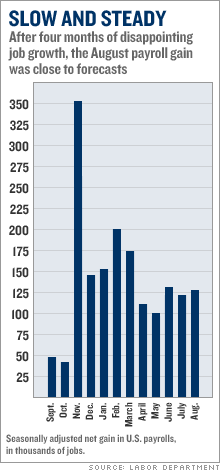Job growth: 'Just right' August payrolls in line with forecasts; unemployment edges lower; wages growing but tame. NEW YORK (CNNMoney.com) -- The latest government job report met both economists' forecasts and Wall Street's best hopes, showing an economy strong enough to add jobs but not so hot as to spark more inflation - and more rate hikes from the Federal Reserve. Employers added 128,000 to payrolls last month, the Labor Department reported Friday, up from a revised 121,000 jobs created in July. Economists surveyed by Briefing.com had forecast a gain of 125,000 jobs.
Last month's payroll growth was the second-strongest gain since March. But, overall, job growth is still seen as sluggish by some economists - the average rise in payrolls over the past 12 month now stands at 142,000, even with the shock to employment caused by the hurricanes at this time a year ago. The good news for job seekers is that the unemployment rate edged down to 4.7 percent from 4.8 percent in July. But, despite the lower unemployment rate, workers' average wages rose just 2 cents, or 0.1 percent, to $16.79 an hour, less than the 0.3 percent rise forecast by economists and well below the revised 0.5 percent increase seen in July. Economists said a bigger jump in job growth or wages could have prompted the Fed to raise interest rates again in its effort to battle inflation, after the central bank paused in its two-year rate-hiking campaign last month. A weaker report would have fanned recent concerns the economy is cooling too quickly, possibly toward recession. Instead, several economists described the August report as "just right." "Does Goldilocks live after all?" asked economist Robert Brusca of FAO Economics. "The report is good and should be deemed good for both bonds and stocks." Wall St. versus Main St. On Wall Street, stocks posted modest gains after the report, while Treasury bond prices fell slightly as investors took a "sell-on-the-news" approach after the bond market's recent rally. Last month's wage gain means hourly pay is up 3.9 percent from a year earlier, the same year-over-year increase seen the previous two months. Anything above 4.0 percent could have made another Fed rate hike more likely at its Sept. 20 meeting. But worker pay is still not keeping up with inflation. The 3.9 percent year-over-year rise means wages trailed the 4.1 percent rise in prices over the 12 months ending in July. Anthony Chan, chief economist for JPMorgan Private Client Services, said that it's possible that inflation readings later in September could change the Fed outlook and lead to a rate hike, but at this point everything appears on course for the Fed to leave rates unchanged once again. "It's the best of all possible worlds. Employment is not falling off the cliff, but we're not seeing the inflationary negatives of growth. This report supports the status quo, and the view that pausing was the right decision." |
| |||||||||||

